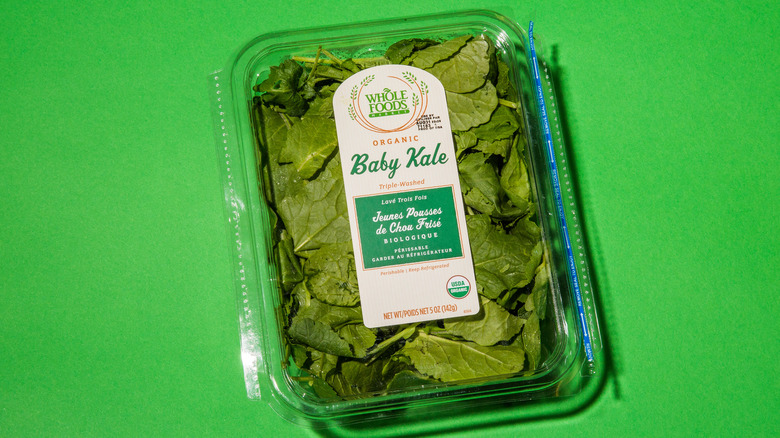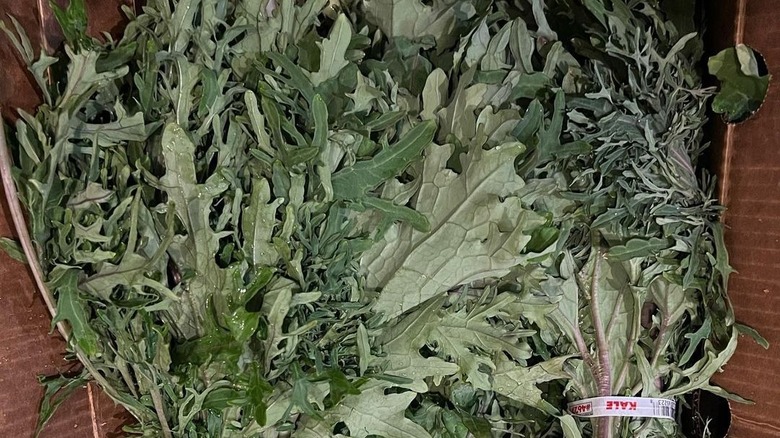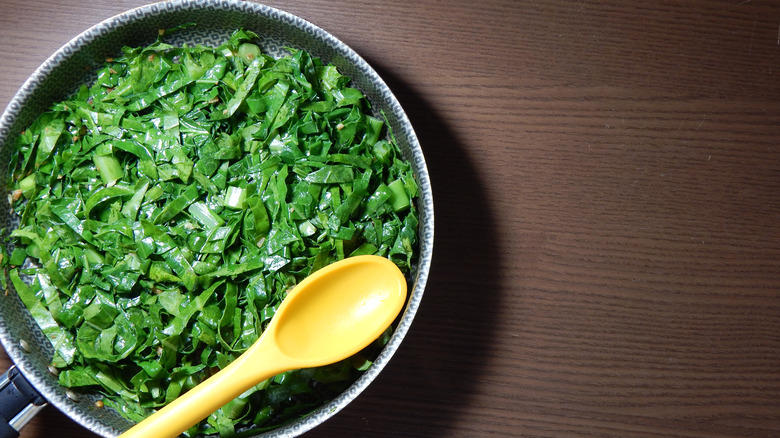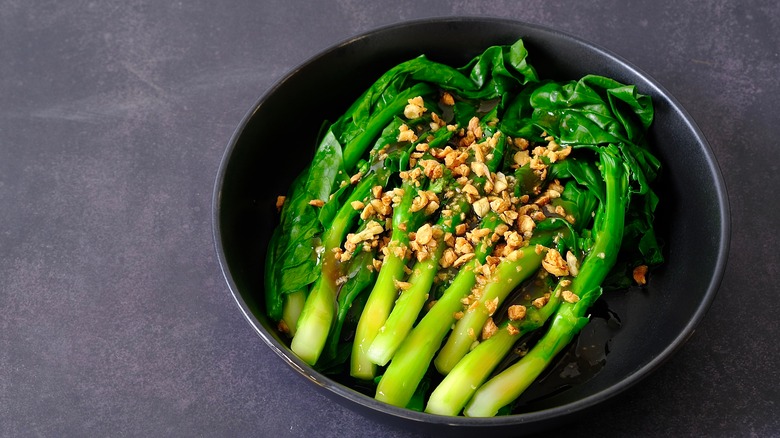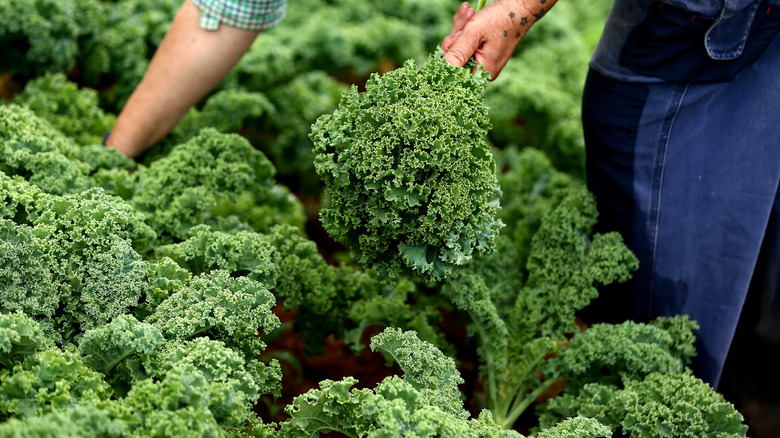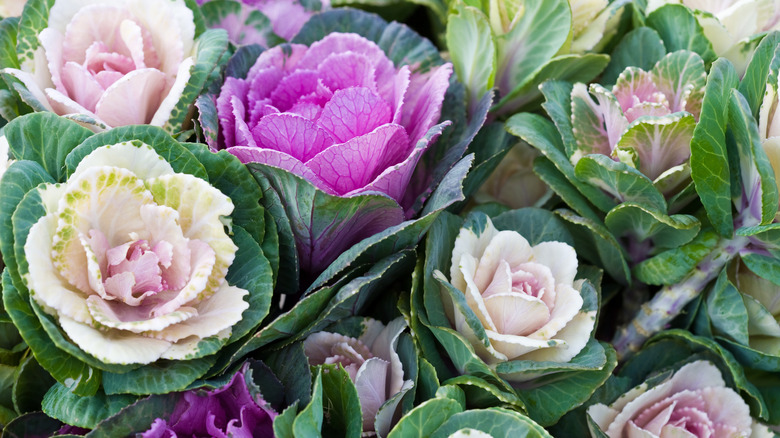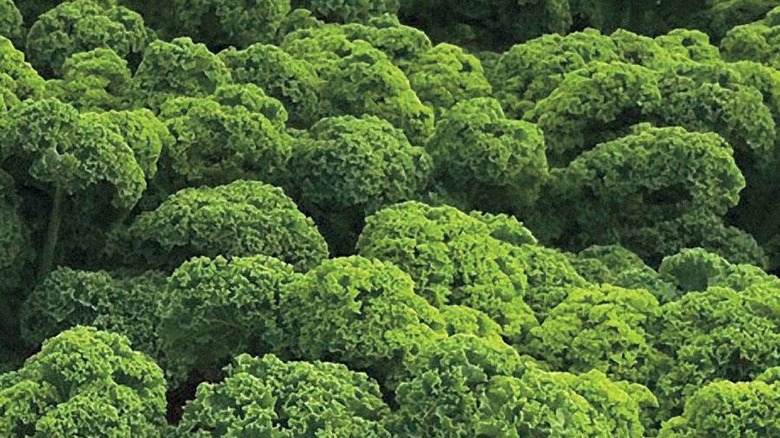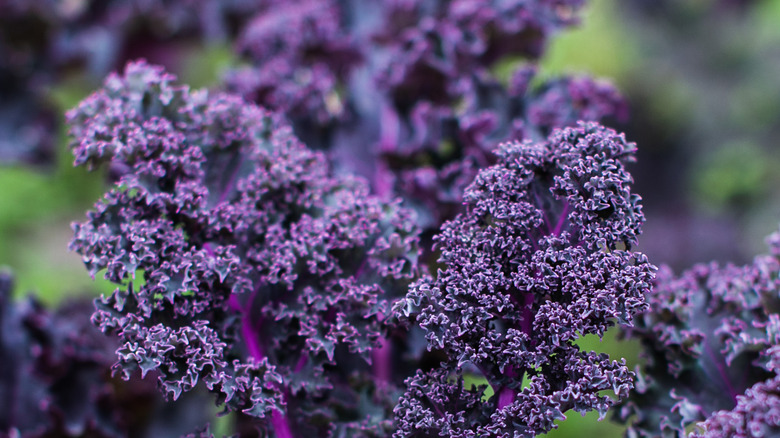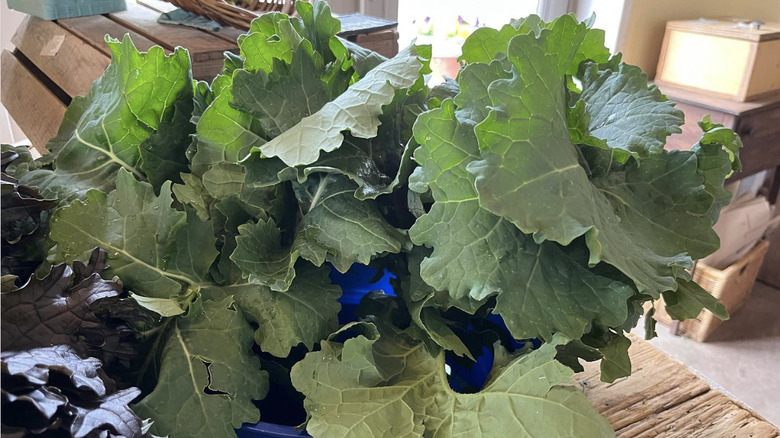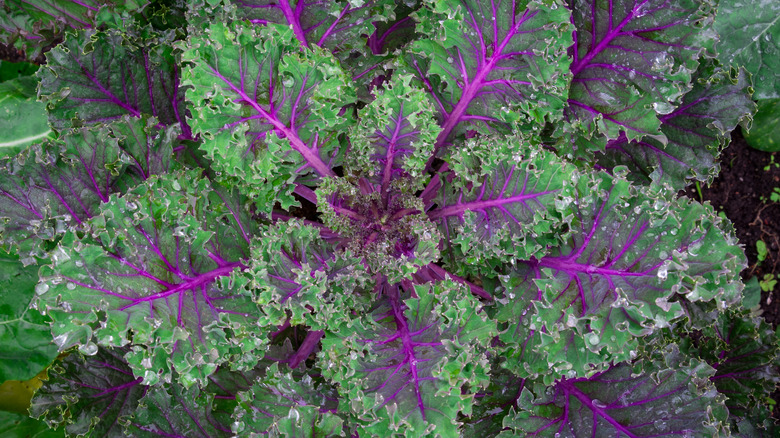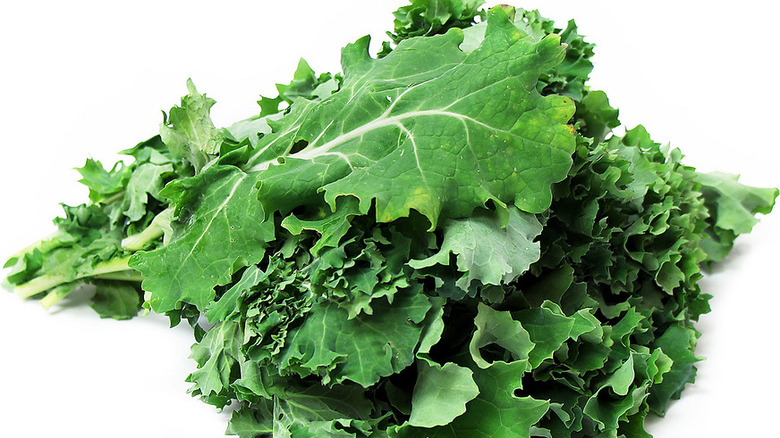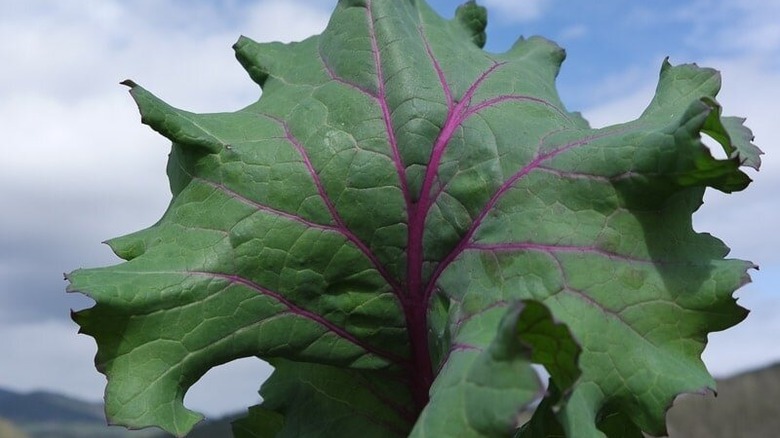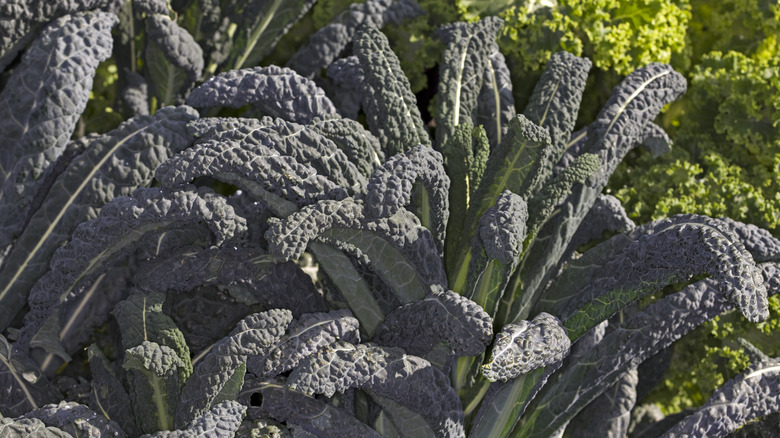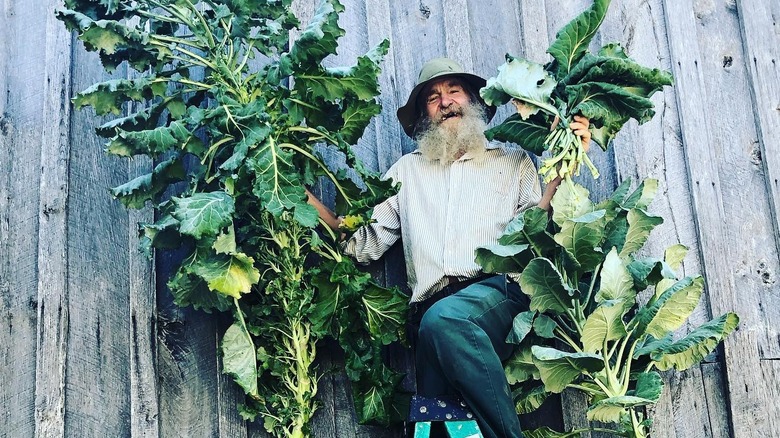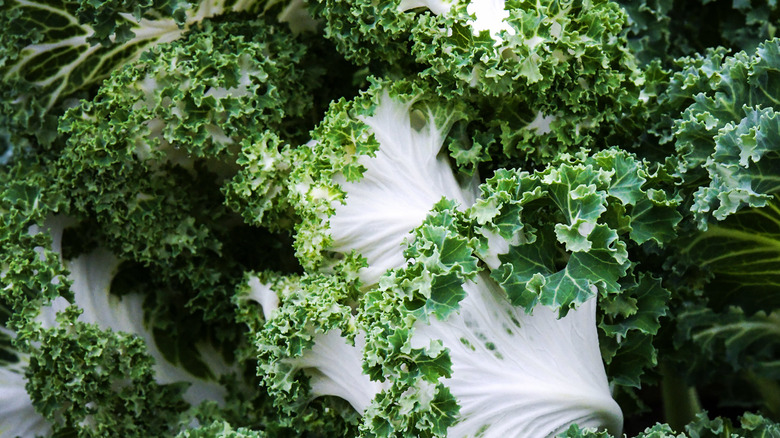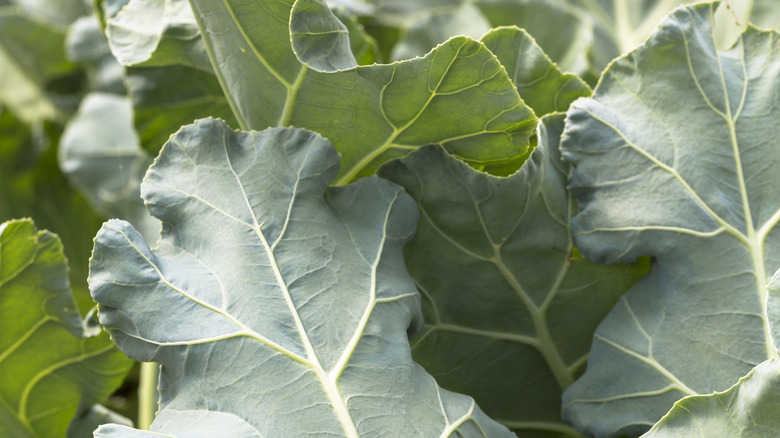A Complete Guide To Every Type Of Kale
Long-relegated to a mere decor item on the salad bars of all-you-can-eat buffets and as an evergreen filler for landscapers and horticulturalists, kale has risen worldwide. This cruciferous green has moved from lawn ornament to much-loved vegan-darling to everyday basic, and is, these days, presented in pasta, scrambles, as a healthy snack, and numerous other preparations — approachable to the average consumer. No longer is Pizza Hut the single largest purchaser of kale in the United States; numerous restaurants, cafes, eateries, and everyday home cooks are happy to buy up the green stuff en masse.
But the vast majority of the eating public may need to realize this leafy green vegetable's sheer number of varieties. Sure, a stroll through the farmers market in the Pacific Northwest may turn up a few different types, but very few folks know the difference between a curly kale and a Chidori, for example. From tender baby kale leaves perfect for sandwiches and salads to hearty and rare varieties like Bear Necessities and Portuguese perfect for braising, kale is a nutrient powerhouse with a type for everyone and every taste worth knowing.
1. Baby kale
The tender, cute leaves packed into containers and lining your grocery's produce section are just the immature leaves of any of several varieties of kale. Most kale is harvested about two months — or 60 days — into its growing season. But baby kale only gets about half that amount of time, and is plucked at around 30 days. The leaves are only a few inches long, but still pack a punch in terms of nutrition. Baby kale is chock-full of calcium, iron, and vitamins A, C, and K1.
The small, less tough, and thinner leaves are ideal for salads, and have a flavor similar to arugula; and can help to lift otherwise tame dishes, like this Panzanella salad. They're a little spicy, a bit peppery, and may even present as nutty for some folks. Baby kale also makes a great addition to smoothies, where the nutrients can be appreciated without the sometimes fibrous mouthfeel of its more mature cousin.
2. Bear Necessities kale
A relative newcomer, Bear Necessities kale burst on the produce scene fairly recently thanks to Oregon farmer Tim Peters. If you're a plant mom (or dad), the leaves of this frilly variety of kale may remind you of a Blue Cross Fern and less of the thick and curly leaves of the kale gracing your local farmers market. Leaves vary from a classic green to a purplish hue. It was developed to be less attractive to kale-loving pests and insects, like the swede midge, which popped up in the U.S. around 2000 and eats away at brassicas like kale.
In terms of flavor and eating, Bear Necessities is said to be a sweeter variety of kale mild enough to be added to salads without massaging; and Croisée des Cultures described it as a cross between Napa cabbage and Siberian kale. You can also add it to bulk up your stir-fries since the leaves tend to hold their shape and contribute a nice, mild flavor.
3. Brazilian kale
Not as common here in the States, but just as delicious as its more easily gotten cousins, Brazilian kale features large, broad, flat dark green leaves that are rounded on the corners. Like most kale varieties, Brazilian kale is high in fiber, iron, and copper, with plenty of vitamins C and A. The stalks are hefty and aren't something you'd want to gnaw on.
In terms of eating, Brazilian kale is pretty popular in South American cooking, where it's used in a variety of dishes including Portuguese soups like caldo verde and feijoada completa, a traditional black bean stew. Leaves can be kept for at least a week, so long as they aren't torn or shredded. Wrap in damp paper towels and store in the refrigerator to enjoy this leafy green for as long as possible. Brazilian kale is an excellent option for dishes like this kale lasagna, which uses cooked kale leaves with mushrooms and garlic for a vegetarian filling.
4. Chinese kale
Often referred to as Gai Lan or Chinese Broccoli, Chinese kale does resemble the leaves of your run-of-the-mill broccoli or broccolini plants, which makes sense when you consider that broccolini is a hybrid created from Gai Lan and broccoli plants. Chinese kale is significantly smaller than most kale varieties, and does sport florets, although much fewer than an average broccoli plant.
The leaves are somewhat bitter, perhaps a bit too much so to make Chinese kale successful in smoothies or salads. But they do lend themselves well to stir-fries — especially with ginger and garlic, a classic Chinese preparation. If you're looking to make your own Gai Lan at home, you can and should use the stalks, too. The entire plant is full of vitamins and minerals, and regular consumption can aid in digestive health, eyesight, and bone strength, according to Happy Grocers.
5. Curly kale
Curly kale — which comes in and covers a huge swath of sub-varieties — is the kale you're likely most familiar with seeing used as a decoration on salad bars at buffets circa 1998. The leaves are dark green and present as slightly curled — think curly parsley or even lace for reference.
Varieties you may be familiar with include Redbor, Darkibor, Winterbor, Scarlet, and Blue Curled Scotch. Most of the time, curly kale is chopped and added to hot dishes; less so used in salads or raw applications. It can be used in salads successfully if it's gone through a bit of a frost, which makes its leaves sweeter, according to Live Eat Learn.
Redbor and Scarlet curly kales boast a striking purple-red color and are richer in anthocyanins and antioxidants than the green varieties. This makes them a popular variety of curly kale for juicing and salads. If you're in the mood for spice, why not try a Mexican kale salad that leans into curly kale's sturdiness?
6. Ornamental kale
In stark contrast to the others on this list, ornamental kale is just that: meant more for looking and not much eating. You can eat ornamental kale, of course, but the flavor is not as satisfactory as say a Lacinato kale or Red Russian kale would be. Ornamental kales come in a variety of tastes and colors. Some common varieties include Chidori and Portuguese kale — both of which can lend themselves well to dishes with long cook times that will help soften leaves and tame some of the more bitter taste associated with this type of green.
Salads probably aren't the go-to recipe if you've come into some ornamental kale leaves. Instead, try a dish like the classic Portuguese soup, caldo verde, which features kale, potatoes, and sausage simmered for about a half hour until everything is soft and delicious. It should be noted that roots on these ornamental kales should be avoided, as they can be toxic.
7. Prizm kale
This hybrid kale is a relative newcomer on the kale scene, and sports short, stemless stalks and ruffled green leaves — less curly than curly kale but curlier than a broadleaf variety. Prizm kale has bright greenish leaves and only gets about 15 inches high, making harvesting a breeze.
The immature leaves can be used for salads and raw applications like baby kale, while the more mature leaves retain some sweetness and gain a nutty, savory flavor that works well in cooking and roasting. Prizm is a wonderful addition to almost any garden and thrives in containers or as an addition to in-ground beds. The leaves are so tightly bunched that you should harvest early and often, as the plant will continue to replenish quickly.
8. Purple kale
Possibly Prince's favorite variety of kale, purple kale sports a beautiful gem-like purple hue on its stems and curled leaves ranging in shades from dark purple to green. The color differences make it a popular ornamental variety but can also be enjoyed in the culinary sense. Stems should be removed as they're especially bitter and not great for eating. However, the leaves make a wonderful addition to salads if you're a fan of the stronger flavor (which is a little similar to raw cabbage).
Younger leaves are more tender and might be easier to eat in salads and smoothies for those who aren't big fans of the tougher leaves and stronger flavor. If you're cooking or roasting your purple kale, the bright color of the leaves will fade a bit, but the purple variety is one of the best choices if you're into the idea of making kale chips.
9. Premier or Early Hanover kale
Known as a compact varietal of kale, Premier kale, also referred to as Early Hanover kale, has broad, flat leaves rich in beta-carotene and antioxidants. If you're keen on a porch or patio garden, Premier kale is one of the best varieties for smaller containers, and when planted in the fall does winter over well indoors, providing a steady yield of leaves perfect for salads, sandwiches, or folding into warm pasta and stews. You can also leave your plant outdoors — just be sure to pluck those leaves before heavy frost, which could damage your plant.
Premier kale has a "mustard greens" taste, making it a great stand-in for collard greens and mustard greens in more wintry recipes, according to Seedway. The leaves are also a bit softer than other varieties, so although massaging for salads is recommended, you're less likely to have stubborn fibers sticking in your teeth.
10. Red Russian kale
A thick reddish, purple stalk and dark green and purply-veined leaves set Red Russian kale apart from other varieties. Also referred to as Red kale, Ragged Jack kale, and Scarlet kale, Red Russian kale has flat, toothed leaves and is often used as a decorative variety. If you live in a colder climate and your Red Russian kale is forced to face harsher conditions, you may notice more reddening of its leaves, according to Specialty Produce.
When eating Red Russian kale, you'll want to ditch those stems; no amount of cooking, boiling, or processing is going to make them much softer, so save yourself the trouble. The leaves, meanwhile, are some of the tastiest eating in the kale world, with many describing them as sweet, mild, and excellent when paired with more complex flavors. They'd make a wonderful addition to this kale slaw with bright orange carrots and purple cabbage.
11. Siberian kale
This frilly kale variety with whitish stems is more closely related to rutabaga than kale, and, not surprisingly, thrives in colder environments. If your yard in Massachusetts could use some greenery, this could be the varietal for you.
The leaves of Siberian kale are much more tender than other kale varieties, and the taste doesn't pack such a strong or bitter bite as other types, making it an ideal candidate for cold-weather salads. The raw leaves are a wonderful source of carotenoids, which help the body more easily absorb fat-soluble nutrients, according to Specialty Produce. It can be cooked or roasted like other varieties of kale, but the softer leaves may not stand up as well to long-simmering stews or soups like thicker-leaved types.
12. Simone Broadleaf kale
Described by Adaptive Seeds as "a beast in the garden," Simone Broadleaf kale is a relatively new varietal with big, broad leaves with wavy — not curly or frilly — edges and ranges in color from dark green to light green to reddish to purply. When you're harvesting Simone Broadleaf, you'll find that the leaves are much easier to strip off of the stem in comparison to other varieties of kale.
This particular variety of kale is a great candidate for baby kale, as it can be picked at as early as 25 days. More mature leaves — which can be picked at around 55 days — are still tender enough to be used in salads and raw applications. The milder flavor may get a bit lost in longer-cooking recipes, but it's a wonderful addition to be added toward the end of a simmering soup or stew.
13. Tuscan, aka Italian, Lacinato, Palm Tree, Black Palm, or Dinosaur
Perhaps the most popular and easily accessed kale on the list, Tuscan kale is the most well-known varietal for most of us perusing the grocery store produce sections. Originally grown in Italy (hence the Italian and Tuscan monikers), Tuscan kale sports long, non-curly, dark green, blackish leaves with a bit of a crinkle to them. Some thought the leaves resembled a dinosaur's skin, hence, the name Dinosaur kale.
Regardless of what you call it, Tuscan kale can be used in a wide array of culinary applications, thanks to a softer stem and not-too-bitter leaves. Stems can be kept on for salads and smoothies as they aren't as woody as other varieties, and leaves can be steamed, blanched, left raw, roasted for chips, or folded into hearty soups. It'd be very at home in this Tuscan kale and cranberry salad for a little sweet, little salty variety.
14. Walking Stick kale
If you have a child stuck in their dinosaur era, Walking Stick kale may be the way to get them to eat their greens. This prehistoric-looking plant grows as tall as 20 feet, and its thick stem is the reason the plant earned its name. When Walking Stick kale was first grown on the island of Jersey, the leaves were fed to livestock, and the thick, dried-out stems were polished and sold as walking sticks. The kale varietal was referred to as Cow Cabbage, Tall Jacks, and Jersey Cabbage, but, eventually did find its way out of obscurity and is now a popular heirloom kale grown by home chefs and farmers alike.
In terms of taste, Walking Stick kale is pretty non-controversial in its flavor. It has the expected taste of standard kale and is best when cooked or even roasted with other vegetables.
15. White kale
If you're looking for a very, strikingly different take on your kale, look no further than white kale. According to Specialty Produce, white kale sports white ribs and dark green leaves as it grows. When mature, the central rosettes of the plant become stark white against the surrounding outer green leaves; a striking appearance that has made the plant popular with landscapers and home gardeners looking to liven up the yard.
When it comes to taste, white kale is one of the more bold varieties of this leafy green. Uncooked leaves are bitter, mustardy, and rather tough, so salads aren't usually the place where white kale can shine (unless you're harvesting young leaves, of course). However, white kale becomes sweeter, more tender, and similar to cooked cabbage once cooked.
16. Sea kale
Arguably one of the weirder-looking varieties of kale (and an excellent source of vitamin C), sea kale was once a popular choice for sailors looking to ward off scurvy. The seamen would harvest and pickle the plant's flowers, pods, stems, and leaves; enjoying it with meals and on its own during long voyages. Today, sea kale is rebounding in popularity although still rarely seen on grocery shelves. An extremely short shelf-life makes mass marketing difficult, but many home chefs and gardeners cultivate the plant.
Sea kale can be eaten raw and cooked, although it's best eaten immediately after harvesting. The tender shoots can be prepped like asparagus (roasted, blanched, or sauteed), while the pods and young leaves can be used as a garnish or in salads.

